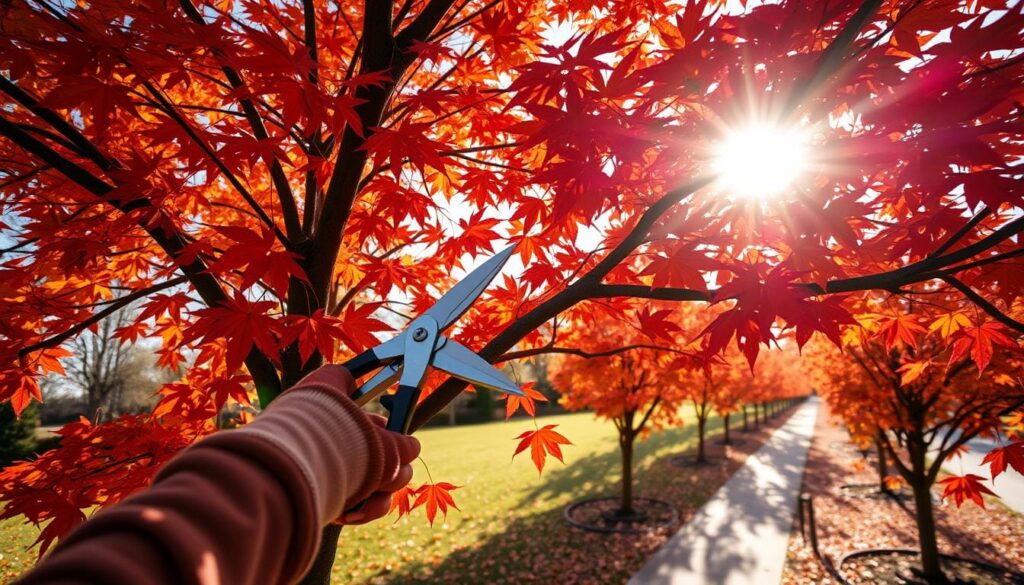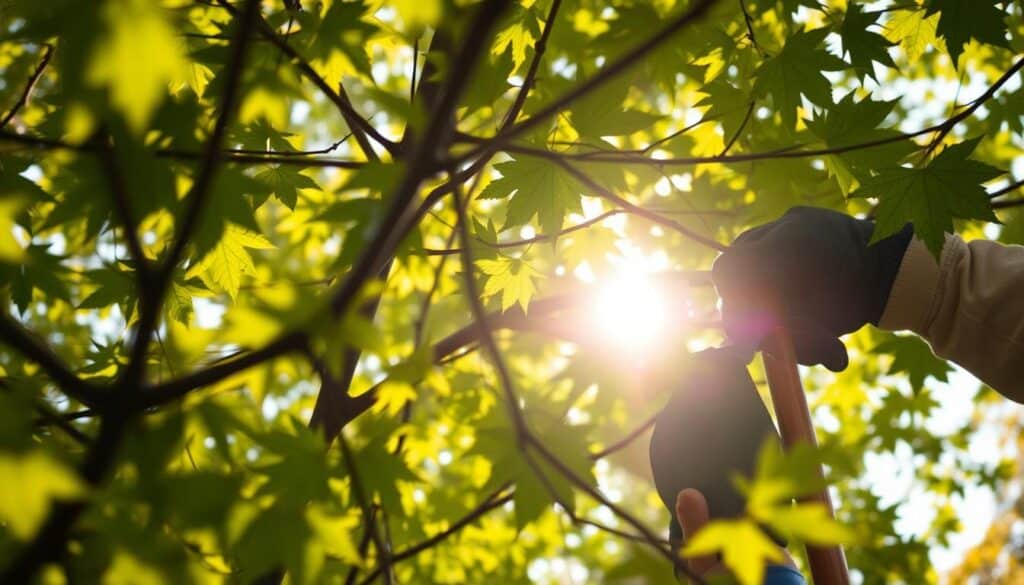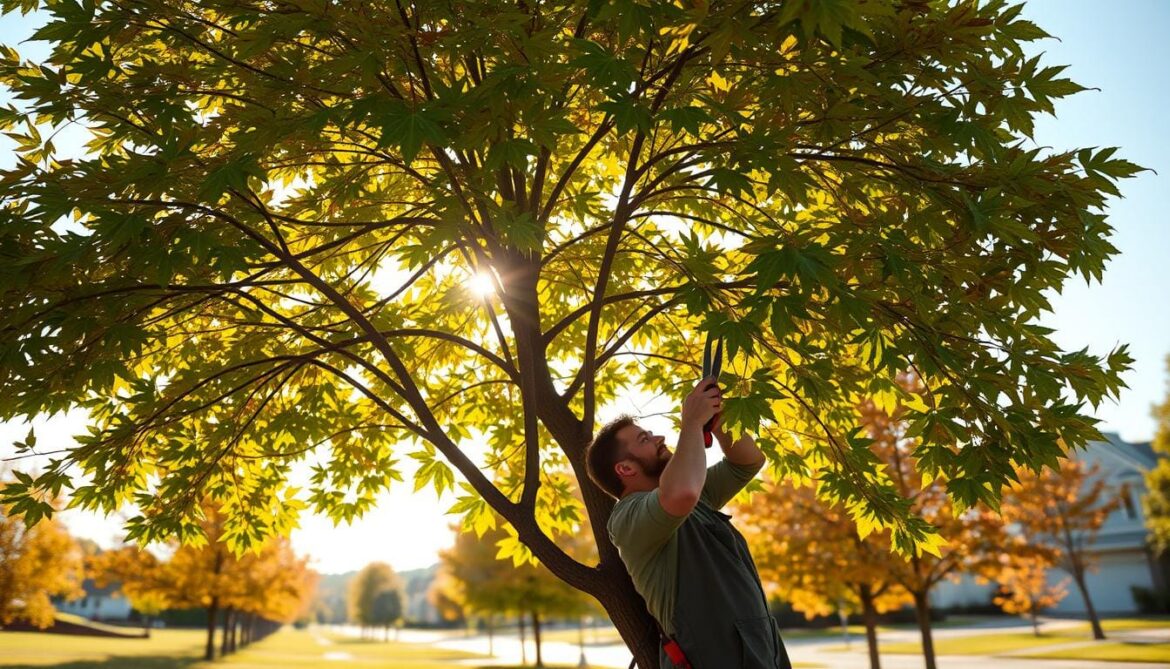For many homeowners, maple trees are a beloved part of their landscape, providing shade, beauty, and a sense of connection to nature. However, to keep these trees thriving, proper pruning is essential.
Pruning at the wrong time can lead to excessive sap bleeding, disease vulnerability, and stunted growth. So, when is the ideal time to trim these trees? Understanding the optimal timing is crucial for maintaining their health and aesthetic appeal.
Key Takeaways
- Pruning maple trees requires careful timing to avoid disease and stress.
- Late winter to early spring is generally considered the ideal window for pruning.
- Proper pruning techniques are just as important as timing for maintaining tree health.
- Avoid pruning during certain seasons to prevent excessive sap bleeding.
- A well-planned pruning guide can help ensure your trees remain healthy and vibrant.
The Best Time of Year to Trim Maple Trees

The timing of pruning maple trees significantly impacts their growth and overall well-being. Pruning at the right moment helps maintain their health and appearance.
Late Winter to Early Spring: The Ideal Window
Late winter to early spring, typically from February to early March, is considered the optimal period for pruning maple trees. During this time, the trees are still dormant, making it easier to identify problematic branches without the obstruction of leaves. Pruning before the spring growth begins allows the trees to direct their energy towards healing wounds and developing new, healthy growth.
Late Summer: A Secondary Option
Late summer, specifically July to August, offers a secondary opportunity for trimming maple trees, particularly for minor pruning and shaping. This period is ideal for controlling the size and shape by removing excess growth after the spring flush has hardened off.
Seasons to Avoid Pruning Maple Trees
It’s crucial to avoid pruning maple trees during the fall, as the wet conditions and falling leaves create a breeding ground for diseases. Similarly, pruning in early to mid-spring when sap is flowing can cause excessive “bleeding.” Pruning should be done on milder winter days when temperatures are above freezing to prevent cold damage.
Why Timing Matters for Maple Tree Pruning

The timing of maple tree pruning is crucial for the tree’s health and longevity. Pruning at the right time helps prevent damage, promotes healthy growth, and minimizes the risk of disease.
Sap Flow and Bleeding Concerns
Maple trees are known to “bleed” or produce significant sap flow when pruned during certain times, particularly in late winter. While this bleeding is primarily an aesthetic concern, excessive sap loss can weaken the tree, especially if it’s young or stressed.
Disease Prevention and Healing
Pruning creates wounds that can serve as entry points for pathogens. Pruning during the dormant season (winter) allows cuts to dry and begin healing before the spring growing season, reducing infection risks.
Impact on Tree Growth and Health
The timing of pruning directly impacts a maple tree’s growth pattern and energy allocation. Dormant-season pruning promotes vigorous spring growth, while late spring pruning can remove valuable energy reserves, potentially stressing the tree.
| Pruning Time | Impact on Maple Trees |
|---|---|
| Late Winter | Significant sap flow; potential for reduced vigor |
| Dormant Season (Winter) | Promotes vigorous spring growth; reduces infection risk |
| Late Spring | Removes valuable energy reserves; potential for stress |
Proper Maple Tree Pruning Techniques

To maintain the health and aesthetic appeal of maple trees, proper pruning techniques are essential. Pruning is not just about cutting branches; it’s about doing so in a way that promotes the tree’s health and longevity.
Essential Tools for Maple Tree Trimming
Having the right tools is crucial for effective pruning. You’ll need pruning shears for small branches, loppers for larger ones, and a pruning saw for branches too large for loppers. Don’t forget safety gear, including gloves and eye protection.
Identifying Which Branches to Remove
Look for dead, diseased, or crossing branches that can harm the tree’s health and structure. Assess the tree’s overall shape and remove branches that disrupt its natural form. Focus on the “Three D’s” – dead, damaged, and diseased branches.
Making the Right Cuts
For smaller branches, use pruning shears or loppers, making clean cuts outside the branch collar. For larger branches, use a pruning saw and make a notch cut on the underside before making the final cut. This technique helps prevent damage to the trunk.
Small Branch Removal
Make clean cuts just outside the branch collar without leaving stubs.
Large Branch Removal
Use the three-cut method to prevent bark tearing: an undercut, a top cut, and a final cut just outside the branch collar.
For more detailed guidance on pruning maple trees, you can visit https://stroberttree.com/blog/when-to-trim-maple-trees to learn about the best practices and timing for pruning.
Conclusion
The key to maintaining healthy and visually appealing maple trees lies in proper pruning techniques and timing. Pruning during late winter to early spring is ideal for major work, as the trees are dormant but preparing for new growth. For lighter maintenance, late summer can be a suitable alternative.
It’s crucial to avoid pruning during fall and early to mid-spring to prevent disease issues and excessive sap bleeding. Regardless of when you prune, using proper techniques and clean, sharp tools is vital. For extensive or complex pruning needs, consider consulting professional tree services to ensure the best care for your maple trees.
By following these guidelines, you can promote the longevity and health of your trees, enhancing their beauty and resistance to environmental stressors. Properly timed pruning not only improves the tree’s appearance but also supports its overall well-being.

